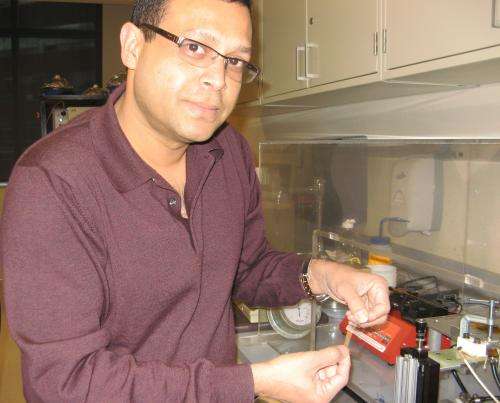Filmmaking magic with polymers: Researchers make breakthroughs in manufacturing copolymer block thin film

(Phys.org) —Think about windows coated with transparent film that absorbs harmful ultraviolet sunrays and uses them to generate electricity. Consider a water filtration membrane that blocks viruses and other microorganisms from water, or an electric car battery that incorporates a coating to give it extra long life between charges.
The self-assembled copolymer block film that makes it all possible is now being fabricated with intricately organized nanostructures, giving them multiple functions and flexibility on a macroscale level never before seen. Gupreet Singh, a Ph.D. candidate in the University of Akron College of Polymer Science and Polymer Engineering, led a team of researchers to devise a method that enables the films to assemble themselves and allows them to serve as templates or directly as end products. The films can be embedded with nanoparticles that enable everything from data storage to water purification.
Superimposed with nanopatterns that allow them to be implanted with a variety of functions—electronic, thermal or chemical—the films can be produced at an industrial level, which is no small feat in the world of science, says research team member Alamgir Karim, associate dean of research for the UA College of Polymer Science and Polymer Engineering and Goodyear Chair Professor of Polymer Engineering. Other research collaborators include Kevin Yager of Brookhaven National Laboratory in Upton, N.Y., Brian Berry of the University of Arkansas and Ho-Cheol Kim of the IBM Research Division of Almaden Research Center in San Jose, Calif.
"We have moved films manufacturing from microns to meter scale, opening pathways from the lab to fabrication," Karim says. "Fundamentally, it allows us to practice nanoscience on a large scale. We can now produce these films quickly and inexpensively, yet with precision and without compromising quality."
Created with speed and uniformity, compatible with flexible surfaces, and subjected to temperature extremes, the copolymer thin films—developed at the National Polymer Innovation Center at UA—are noted in two recent ACS Nano journal articles "Dynamic Thermal Field-Induced Gradient Soft-Shear for Highly Oriented Block Copolymer Thin Films" and "Large-Scale Roll-to-Roll Fabrication of Vertically Oriented Block Copolymer Thin Films".
Funded by the National Science Foundation, the research represents a market-ready revival of a technology developed by Bell Laboratories in the 1950s for metal and semiconductor purification and adapted in the 1980s for polymer crystallization. Since then, the technology remained dormant, until now.
"We revived the technology and made it scalable, opening opportunities for full-scale manufacturing," Karim says, noting that IBM has expressed interest in continuing the research and development of the technology and is exploring applications ranging from membranes for batteries to high-density magnetic tape storage.
"The process should be of interest to a broad range of industries—from high-tech to low-tech—worldwide," Karim adds. "Manufacturing of these nanostructures can be done on industrial platforms such as UA's roll-to-roll manufacturing (developed by collaborator Distinguished Professor of Polymer Engineering Miko Cakmak) at relatively high speeds not possible previously."
Journal information: ACS Nano
Provided by University of Akron



















